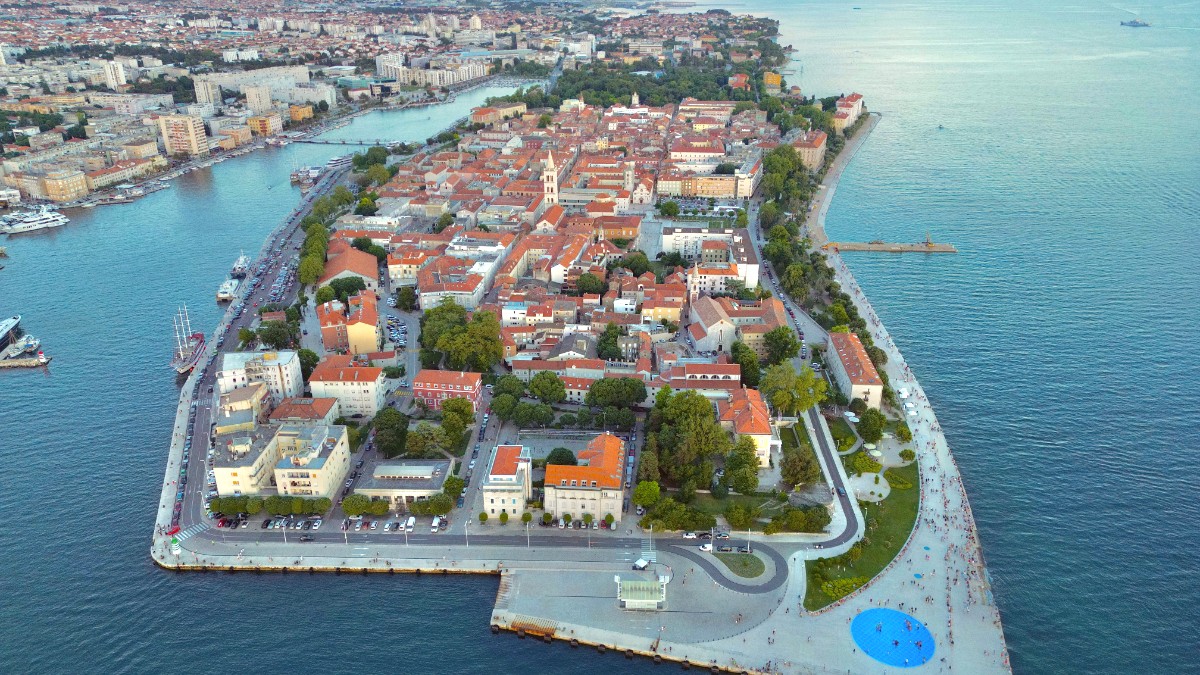
Dalmatia, Croatia
These sites are the heart of Zadar's appeal. The Sea Organ and Greeting to the Sun are unique modern installations, while the Roman Forum and St. Donatus Church represent ancient history.
Explore the blend of old and new at your own pace.
The Land Gate has a winged lion of St. Mark and St. Chrysogonus on horseback.
Largest Roman forum on the Croatian Adriatic side. Openly accessible.
Impressive Venetian-built walls, an UNESCO World Heritage Site.
Houses the intricately carved wooden sarcophagus of St. Simeon.
Historic square with five ornamental wells, part of city's water supply.
Main street of Zadar's Old Town, dating to Roman times, lively promenade.
Zadar has access to beautiful natural landscapes, both within the city and nearby.
Zadar's main city beach, south of Old Town. Pebbles and paved areas, clear water, Blue Flag status.
First public park in Zadar (1829), atop city walls. Shaded paths, views, green oasis.
Bell Tower of Zadar Cathedral offers panoramic views. Zadar Riva has excellent sunset views over the Adriatic.
~45 km north. Famous for dramatic canyons, climbing, hiking in Velebit mountain range.
~80 km southeast. Stunning series of seven waterfalls (Skradinski Buk), lush surroundings.
Archipelago of 89 islands, a "nautical paradise." Accessible by organized boat tours.
A fun, interactive museum with optical illusions and puzzles. Popular with families.
A unique sphinx sculpture, reportedly grants wishes if you know how to ask. Located in Brodarica.
Short ferry ride from Zadar, laid-back island atmosphere, beautiful beaches, St. Michael's Fort views. A quiet escape.
Explore Zadar's cultural depth through various activities.
To maximize your visit, group nearby attractions. The Old Town is pedestrian-friendly, making it easy to walk between historical sites and modern installations.
For national parks, consider full-day trips. Many tour operators in Zadar offer organized excursions.
Many attractions are free, but museums and some church interiors have entrance fees.
The Old Town is best explored on foot. For areas outside, local buses or taxis are options.
Visiting during shoulder seasons (May-June, September-October) offers pleasant weather and fewer crowds.
Guided tours can offer insights into Zadar's history and culture. Look for local experts.
Explore some of Zadar's less-known but equally charming spots.
A less traditional museum, great fun for all ages with interactive exhibits.
A unique local landmark built in memory of a lost love, located in the Brodarica area.
On Ugljan Island, a short ferry ride away, with panoramic views of Zadar and the archipelago.
A remarkable collection of ecclesiastical art in the Benedictine convent of St. Mary.
Ancient Roman town ruins near Zadar, offering a glimpse into a forgotten past.
A fun and interactive experience suitable for all ages, a departure from traditional museums.
Experience local life and fresh produce at the daily green and fish markets.
Walk along sections of the historic Venetian walls for views and a sense of history.
Optimize your sightseeing with these practical suggestions.
Capture Zadar's beauty with these photography pointers.
When visiting churches or religious sites, dress respectfully, covering shoulders and knees.
Photography might be restricted in some museum areas; look for signs.
A quick guide to navigating Zadar's many sights.
Dedicate at least one full day to explore the Old Town on foot.
Plan separate days for excursions to nearby natural wonders.
Take a ferry to explore the relaxed atmosphere of nearby islands.
Consider renting a bicycle on the island for easy exploration.
Zadar's museums offer diverse historical and artistic collections.
Check for combined tickets or Zadar Card for potential savings.
Engage with Zadar's local culture for a experience.
Local cafés and konobas (taverns) offer authentic experiences.
Focus on the core historical sites, ending with the Sea Organ sunset.
Take a day trip to Krka National Park or Paklenica National Park.
Visit Ugljan Island or explore Zadar's museums and local markets.